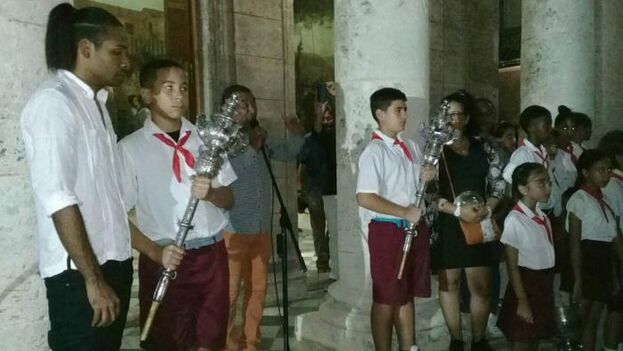
![]() 14ymedio, Juan Izquierdo, Havana, November 16, 2022 — A strange mixture of rites, which have become commonplace in recent years, came together on Tuesday night at the ceremony held at the founding site of Havana, the Ceiba de El Templete, on the eve of its 503rd anniversary.
14ymedio, Juan Izquierdo, Havana, November 16, 2022 — A strange mixture of rites, which have become commonplace in recent years, came together on Tuesday night at the ceremony held at the founding site of Havana, the Ceiba de El Templete, on the eve of its 503rd anniversary.
It was attended by the highest authorities of civil power, Luis Antonio Torres Iríbar, first Secretary of the Party in the capital, and Reinaldo García Zapata, governor of the city, but also those of the church. Specifically, Juan de la Caridad García Rodríguez, archbishop of Havana, from whom “the people received a blessing” and who accompanied a procession through the streets surrounding the Plaza de Armas.
However, the most surprising image of the evening — in addition to being extremely worrying if it’s confirmed that the maces are the original pieces — was that of two children, dressed in white shirts and red scarves, the uniform of the Pioneers, holding the maces of the old Havana Cabildo. Made of silver in 1631, they are, according to Emilio Roig de Leuchsenring in his book Havana. Historical Notes, “the oldest works of art in Cuba.”
Both valuables objects are in the custody of the Office of the Historian, founded by Roig and administered until 2020 by the late Eusebio Leal, and they are stored in the former Palace of the Captains General, today the City Museum. It’s not the first time they have been taken out of safekeeping for the same ceremony.
The official press echos “an emotional letter calling for the conservation of historical heritage,” “warm and simple words” that, says Tribuna de La Habana, “sixth-grade pioneer Laura Hernández García, from Camilo Cienfuegos Primary School, read” at the ceremony.
The ceremony ended, the official press reports, with the song Razo a la Ceiba by Leo Vera, and a concert on the esplanade of El Templete.
Beyond the unease caused by seeing the little Pioneers, ignorant of the historic value of what they carried in their hands, no one is surprised that the celebration of the foundation of the capital mixes ideology and religion.
In 2019, the Cuban regime paid tribute to the priest Guillermo Isaías Sardiñas Menéndez, known as Father Sardiñas, on the 55th anniversary of his death.
Nicknamed the “father of the olive green cassock,” the official press has frequently praised “the coherence between his religious faith and his conviction as a patriot and revolutionary,” although in the historiography of the Catholic Church the mentions of his actions have been more discreet.
But the intersections have not only been between Cuban communist ideology and Catholicism. In 2008, fifty santeros officiated a ritual with drums and animal sacrifices to wish “long life” to Fidel Castro on the day of his 82nd birthday, then convalescing from an intestinal disease.
Translated by Regina Anavy
____________
COLLABORATE WITH OUR WORK: The 14ymedio team is committed to practicing serious journalism that reflects Cuba’s reality in all its depth. Thank you for joining us on this long journey. We invite you to continue supporting us by becoming a member of 14ymedio now. Together we can continue transforming journalism in Cuba.
